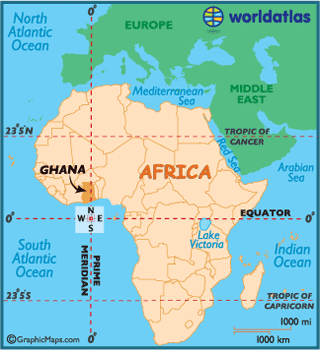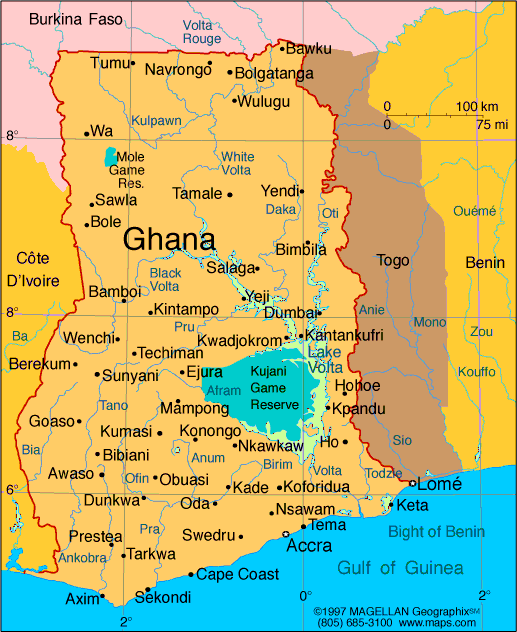A while ago I taunted you with the prospect of a post about ethnicity in
Ghana. I’ve since realized that this was
probably a mistake, as it’s a big topic and I lack the expertise to do it any
kind of justice – but I’ll make a start and give it my best shot. Most of the facts and figures quoted come
from the Bradt guide to Ghana and Wikipedia, but I have to take responsibility
for the text and I don’t feel all that confident that everything is totally
correct.
I remember hearing, in the early days of research into the human genome,
that there is more genetic diversity in Africa than in all of the rest of the
world. This is consistent with the
theory that all non-African people are descended from a single small group of homo
sapiens who walked out of Africa at the end of a period when life on the
African continent had been very tough , seeing the extinction of many species
of hominid. You might recall the BBC’s
series “Walking with Cavemen”, which touched on this. I suspect the research might have advanced
over the past couple of decades and I haven’t kept up with it – but it strikes me
that one thing to look at is what other populations of homo sapiens persisted
in Africa; there must have been some apart from the walkers that populated the
rest of earth, otherwise there wouldn’t be a wider gene-pool here. I mention this simply because, as a starting
point, there is no good reason to expect that the people now living in Ghana
would have a single or simple ethnicity, and every reason to expect the
opposite.
When you reach Accra, you are disappointed by the lack of buildings with
any history there (contrast South America, where the architectural legacy of
the conquistadores is all around you, even in quite small and out-of-the-way
places – and where in a place like the Colca canyon in Peru you can see
terraced field systems and irrigation infrastructure which, in their scale
alone, tell you that the land has been occupied for a very long time indeed). When you leave Accra, your disappointment continues. There are some ancient mosques in the
northern part of Ghana – one at Larabanga, near the Mole National Park, gets
quite a bit of coverage in the guide books and is variously dated to the 13th
century, to 1643-75, and other dates in between – all with apparently little foundation
in documentary or forensic evidence. But
overwhelmingly, what you see as you travel are functional, contemporary
buildings. People don’t seem to have
built “beautiful” or “artistic” or even “symbolic” structures, or had a sense
of wanting to leave a bit of themselves for future generations to see. As far as I can see, they still don’t (maybe an
exception – a nice modern mosque seems to be going up in Tamale; and there’s
also something which might turn out to be quite grand in its early stages in
Bolgatanga). I don’t really know what to
make of this fact. Is the process of
surviving until tomorrow so arduous here that it blots out all other
thoughts? Do people here naturally leave
a light footprint on the land? Or, to
quote Simon and Garfunkel, is it just imagination they lack? Whatever it is, somehow it doesn’t feel quite
right – at least to someone who likes crawling around in Neolithic burial
mounds, reads Beowulf and listens to early music.
Incidentally, tomorrow we are heading south and will visit the city of Cape
Coast, which is one of the few places in Africa where you can see the tangible
vestiges of the slave trade, in the shape of “castles” that date back to the 17th
century (on a site where Europeans first started building in 1482). Maybe I’ll blog about that at some point.
There is nothing historically authentic about the borders of the modern
country “Ghana”. They are entirely the
construct of the European powers who divided up Africa among themselves in the
colonial period. The British Gold Coast colony
came into existence in 1873 but didn’t extend all that far inland; the central
and northern parts of the country was added on in 1902; and the land to the
east of Lake Volta, which had previously been part of German Togoland, was
given to Britain by the League of Nations in 1919. The name “Ghana” is ancient but doesn’t
actually belong to this bit of land, and was only linked with it on
independence (it was picked, maybe for mainly symbolic reasons, by the great freedom
campaigner and Ghana’s first president, Kwame Nkrumah; some historical justification
linking the people here with the people of the ancient empire of “Ghana” was offered
by some local historians, but it was flimsy at the time and has subsequently
been discredited). However, despite the
intrinsic falseness of the country, it celebrated its 50th
anniversary in 2007 and I haven’t met anyone here who doesn’t consider herself
or himself to be a “Ghanaian”. They also
consider the neighbouring countries of Burkina Faso (to the north) and Togo (to
the east) to be foreign lands – despite the fact extended families have members
on both sides of those borders. Maybe it
helps that the “national” language there is French – Ghanaians don’t have a
very good track-record of learning French, as I’ll tell you on another
occasion.
The name “Ghana” belonged to an empire which was at the height of its
powers around the year 1,000 and had its capital at Kumbi Saleh, whose ruins
still exist and are in Mauritania quite close to the border with Mali. Its eastern and western borders were,
approximately, the rivers Niger and Senegal, and its southern extremity was a
good way north of modern Ghana. Its people are believed to have been
Mande-speakers. This empire seems to
have begun to fragment towards the end of the 11th century and was
progressively replaced by a different empire, formed by Mandinka people of
Kangaba, which eventually occupied most of the same territory plus some other
land. Its name was “Mali” – not, of course,
synonymous with the current country of Mali. It’s of passing interest that there is some
evidence of Muslim communities in “Ghana” – from which one can infer that the
empire as a whole wasn’t Muslim; by contrast, “Mali” seems to have been Muslim. The Mande-speakers rose again though, in the
shape of the Songhai Empire which was based to the north of what is now Burkina
Faso and seems to have been the main Sahel trading intermediary by the end of
the 15th century. That empire
suffered a catastrophic attack from an army from Morocco in 1591 and wasn’t succeeded
by another, such was the success of the sea-based trade route.
These ancient empires were in territory which we would describe now as
Sahel – by which we mean an arid region of savannah south of the Sahara Desert,
where permanent human habitation is only possible close to the big rivers
(Senegal, Volta, Niger). We haven’t
ventured into the Sahel yet but I’d like to, given that we are this close. Zebilla isn’t Sahel and I guess you’d describe
it as “dry” rather than “arid”; one significant factor is that it has a rainy
season (though it’s anybody’s guess how long that will survive global climate
change – it isn’t long ago that the seasons here were highly predictable, but
they aren’t now and last year the rains started considerably later than “normal”).
North of the Sahara are the communities of the southern Mediterranean. They have traded with the lands south of the
Sahara for – well, nobody actually know, of course; there is physical evidence
going back to about 500 BC, so it has obviously been a long, long time. The empires of the Sahel might not have had
all that much of their own to trade, given the arid condition of the land and maybe
lack of obvious other natural resources.
But they seem to have controlled the trade with the fertile areas
further south – which include moist savannah and rain-forest - and by all
accounts made a jolly good living out of it, for upwards of a thousand years
and maybe two, thank-you very much. The
lands to the south produced and traded kola nuts, gold and ivory, and no doubt
other stuff too; and they might have had a use for the salt, fine cloth other
luxury goods that the caravans brought south down the trade route. It was the Portuguese who led the way to find
a sea-based trade route to these goods and the rest, as they say, is history. There’s gold here to this day (we hope to
visit a goldmine in Burkina Faso soon) but hopefully the trade in ivory has
stopped.
So who were the people further south – in what is now Ghana? Perhaps that is just about enough of a cliff
for me to be able to leave you hanging off it until the next instalment.

